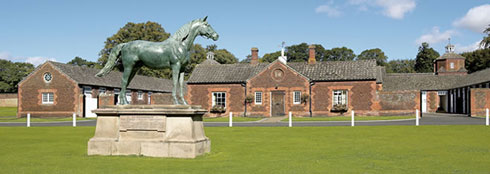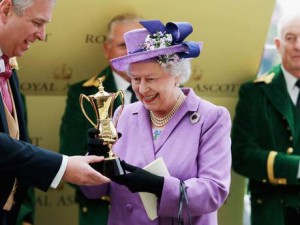Sport of Queens
By Staff Report September 7, 2013The Queen of England personally names all her Thoroughbreds. This was one of the tidbits revealed in a lengthy CNN article about Queen Elizabeth II’s passion for horse racing.
Although Britain’s royal family boasts many generations of horse lovers who have participated in everything from fox hunting to polo to Thoroughbred racing, it was only this year that Queen Elizabeth at age 87 became the first sitting monarch to win the prestigious Gold Cup at Royal Ascot when her 4-year-old filly Estimate took top honors.
“She names all her own horses, I believe — it gives her fantastic pleasure, planning the whole process,” Nick Attenborough, spokesman for Great British Racing, told CNN reporter Paul Giddings. “She has inherited her father King George VI’s love of the turf,”
The article goes on to detail the love Elizabeth’s mum, known as the Queen Mother, had for the sport of steeplechase racing, which involves not only racing on the flat but also jumping imposing brush hurdles over lengthy tracks.
The Queen Mother racked up449 wins under her royal colors when she died 11 years ago at age 101.
The Queen Mother Champion Chase, one of 27 classes to take place at the Cheltenham Festival Races in Gloucestershire, is named in her honor. The 2014 Festival takes place March 11-14 in the spa town on the edge of the Cotswolds.
Both she and her daughter coveted the honor of wining the Grand National race made famous first in the 1935 novel by Enid Bangold, and then in the 1944 film starring Elizabeth Taylor and Mickey Rooney, but that is one trophy that has thus eluded the royals.
Founded at Hampton Court in the 16th century, the Royal Stud has been closely linked to the evolution of the Throughbred horse. Today, Queen Elizabeth’s full-scale racing operations include the Royal Stud at Sandringham, in Norfolk, about 100 miles northeast of London, and another at Polhampton in Berkshire, an hour’s drive west. She introduces about 25 horses into her training program each season.
One of the stallions at Sandringham is former Derby winner Motivator, with the queen part of a syndicate using the horse for breeding.
A Royal Mews has existed at Buckingham Palace since 1761, having become a substantial establishment during Queen Victoria’s reign as the number of horses and staff expanded to fit the requirements of the Sovereign’s family and official household.
The Royal Mews at Buckingham Palace is to this day a busy working yard that houses about 30 carriage horses, principally Windsor Grays or Cleveland Bays, and employs more than 30 members of staff including liveried helpers and coachmen. The Royal Mews was founded in 1761 and became a substantial establishment during Queen Victoria’s reign (1837-1901) as the number of horses expanded.
Other points of interest in the CNN article:
- Queen Victoria was such a zealous enthusiast, she “broke the window in the royal box at Ascot in a rush to see the finish” of a race.
- Queen Elizabeth’s interest prompts “low-key visits in a private capacity to racetracks such as Newbury…to check on the progress of her horses,” according to Attenborough, who adds, “Most of the crowd would be unaware she is there, walking around the paddock, possibly wearing a head scarf.”
- Great British Racing, the promotional body for British horseracing interests around the world, sent the Queen’s new gransdson, Prince George, a teddy bear dressed in the monarch’s racing colors as an introduction to the sport the group hopes he will embrace.
Short URL: https://theequestriannews.com/?p=17021




